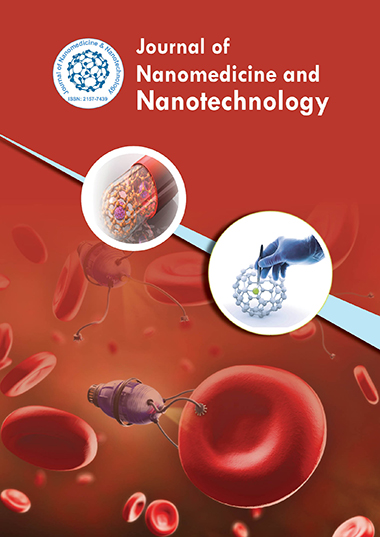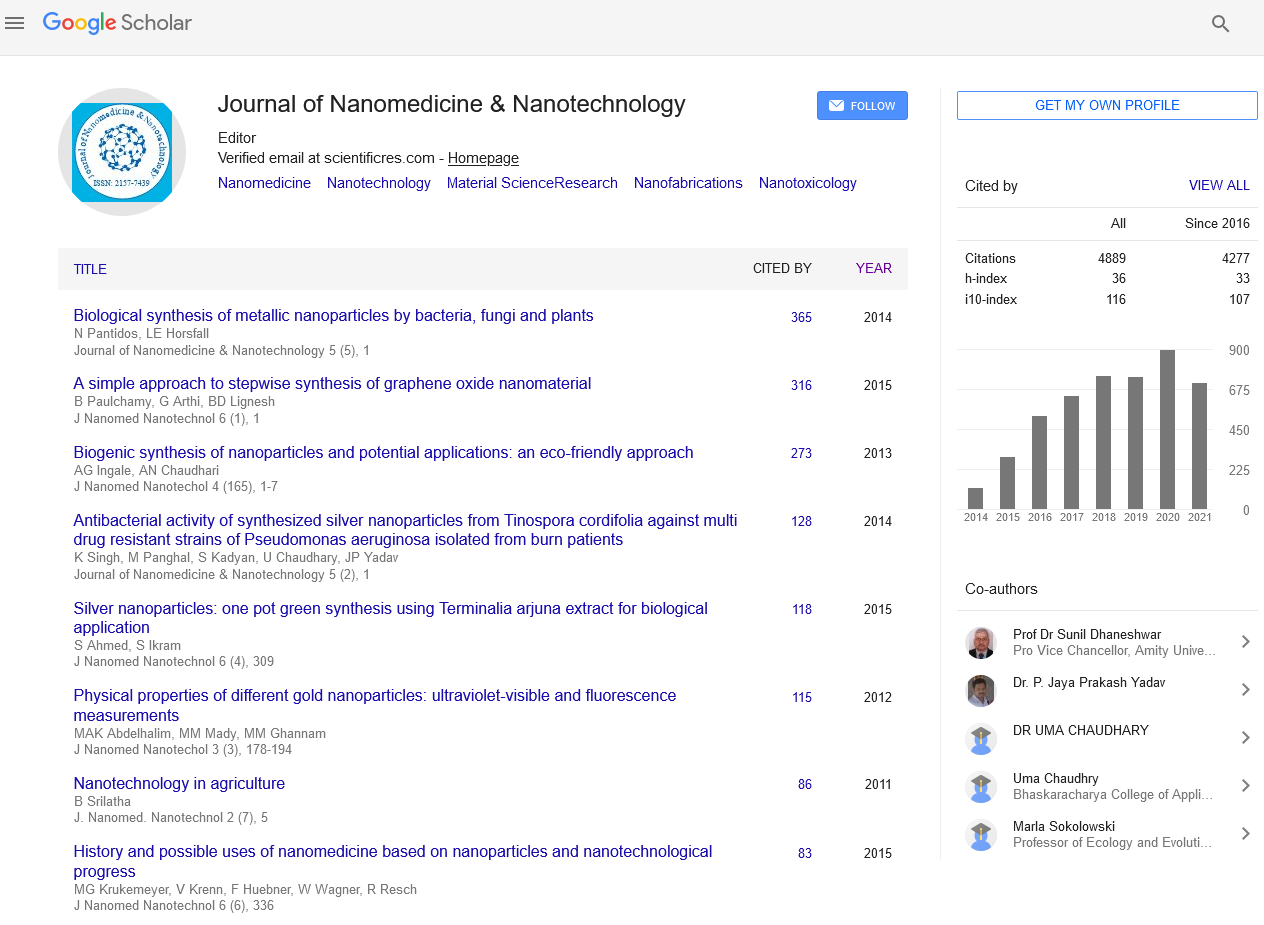Indexed In
- Open J Gate
- Genamics JournalSeek
- Academic Keys
- JournalTOCs
- ResearchBible
- China National Knowledge Infrastructure (CNKI)
- Scimago
- Ulrich's Periodicals Directory
- Electronic Journals Library
- RefSeek
- Hamdard University
- EBSCO A-Z
- OCLC- WorldCat
- SWB online catalog
- Virtual Library of Biology (vifabio)
- Publons
- MIAR
- Scientific Indexing Services (SIS)
- Euro Pub
- Google Scholar
Useful Links
Share This Page
Journal Flyer

Open Access Journals
- Agri and Aquaculture
- Biochemistry
- Bioinformatics & Systems Biology
- Business & Management
- Chemistry
- Clinical Sciences
- Engineering
- Food & Nutrition
- General Science
- Genetics & Molecular Biology
- Immunology & Microbiology
- Medical Sciences
- Neuroscience & Psychology
- Nursing & Health Care
- Pharmaceutical Sciences
Editorial - (2025) Volume 16, Issue 2
The Role of Nanohedron in Precision Nanofabrication and Applications
Everett Quinnell*Received: 01-Mar-2025, Manuscript No. jnmnt-25-28607; Editor assigned: 05-Mar-2025, Pre QC No. jnmnt-25-28607 (PQ); Reviewed: 20-Mar-2025, QC No. jnmnt-25-28607; Revised: 25-Mar-2025, Manuscript No. jnmnt-25-28607 (R); Published: 31-Mar-2025
Abstract
Nanohedron, a structural nanomaterial with precisely controlled geometric configurations, has emerged as a critical component in precision nanofabrication. These nanoscale polyhedral structures exhibit exceptional mechanical, electronic, and optical properties, making them highly suitable for advanced applications in material science, electronics, catalysis, and biomedical engineering. The ability to manipulate matter at the atomic and molecular levels using nanohedra enhances device performance and functionality in various technological domains. However, challenges in synthesis, stability, and scalability must be addressed to fully leverage their potential. This article explores the significance of nanohedron structures in nanofabrication, their applications, associated challenges, and future directions.
Keywords
Nanohedron; Nanofabrication; Nanoscale materials; Nanotechnology; Precision manufacturing; Self-assembly; Quantum dots; Catalysis; Biomedical applications; Nanoelectronics
INTRODUCTION
The rapid advancement of nanotechnology has led to the development of highly controlled nanoscale structures, among which nanohedron stands out as a key innovation. A nanohedron is a polyhedral nanostructure characterized by its precise geometry and atomic-scale uniformity, offering superior mechanical strength, stability, and functional adaptability. These properties make nanohedra ideal for applications in electronic devices, catalysts, and biomedical tools. By integrating nanohedron structures into precision nanofabrication techniques, researchers can achieve enhanced material properties, leading to improved efficiency and miniaturization of modern technologies. This article delves into the role of nanohedron in nanofabrication and its diverse applications [1,2].
DESCRIPTION
Nanohedra are meticulously engineered nanostructures, often composed of metals, semiconductors, or hybrid materials. Their unique geometric configurations enable superior control over surface area, reactivity, and electronic properties. The synthesis of nanohedra typically involves techniques such as [3,4].
Self-assembly methods: Molecular self-assembly processes allow for the formation of well-defined polyhedral nanostructures with minimal defects.
Template-assisted growth: Predefined nanoscale templates guide the formation of nanohedra, ensuring uniformity and high precision.
Chemical vapor deposition (CVD): A widely used technique for producing nanomaterials with controlled dimensions and material composition.
Electrochemical synthesis: This method enables the fine-tuning of nanohedron properties by adjusting electrolyte conditions and deposition parameters.
The ability to fabricate nanohedra with customized properties has led to their integration into multiple technological fields [5]..
DISCUSSION
The applications of nanohedron in nanofabrication and beyond are vast and transformative:
Nanoelectronics: Nanohedra play a crucial role in the development of quantum dots, transistors, and memory storage devices, enabling next-generation electronic components that are smaller, faster, and more efficient.
Catalysis: Due to their high surface-area-to-volume ratio and controlled geometry, nanohedron structures significantly enhance catalytic efficiency in chemical reactions, including fuel cell development and environmental remediation.
Biomedical applications: Nanohedron-based drug delivery systems offer targeted therapy by improving bioavailability and reducing side effects. Additionally, they serve as scaffolds for tissue engineering and diagnostic imaging tools.
Optoelectronics and photonics: Nanohedra improve light absorption and emission in devices such as LEDs and solar cells, optimizing energy efficiency and performance.
Metamaterials: The unique properties of nanohedra contribute to the design of metamaterials with applications in cloaking devices, sensors, and high-performance coatings [6,7].
Despite these advancements, several challenges hinder the widespread adoption of nanohedron structures:
Scalability issues: Large-scale production of nanohedra with consistent quality remains a technical challenge.
Stability concerns: Some nanohedra exhibit instability under varying environmental conditions, limiting their practical use [8,9].
High fabrication costs: The precision required for nanohedron synthesis increases production costs, necessitating more cost-effective fabrication techniques.
Addressing these challenges requires interdisciplinary collaboration and continued research in material science and nanofabrication technologies [10].
CONCLUSION
Nanohedron represents a revolutionary advancement in precision nanofabrication, offering unparalleled control over material properties at the nanoscale. Its applications in nanoelectronics, catalysis, biomedical engineering, and photonics highlight its transformative potential in various industries. However, overcoming challenges related to scalability, stability, and production costs is essential for broader implementation. Future research efforts should focus on developing innovative synthesis techniques, enhancing material stability, and improving cost-efficiency to unlock the full potential of nanohedron-based technologies. As the field of nanotechnology continues to evolve, nanohedron is poised to play a crucial role in shaping the future of advanced materials and precision manufacturing.
ACKNOWLEDGEMENT
None
CONFLICT OF INTEREST
None
REFERENCES
- Li C, Li Q, Zeng Z, Zhou X. Dispersions of hydrophobic magnetite nanoparticles in nonpolar solvents with different surfactants: the effect of surfactant chain length and surfactant concentration. J Colloid Interface Sci. 2019;539: 567-577.
- Zhang S, Bellinger A, Genshaft A. A blood–brain barrier–penetrating gut-microbe-derived molecule that enhances amyloid beta deposition and cognitive impairment in a mouse model. Science Advances. 2021; 7(23): eabf1773.
- Tong R, Chiang HH, Kohane DS. Photoswitchable nanoparticles for in vivo cancer chemotherapy. Proc Natl Acad Sci. 2020; 110(46): 19048-19053.
- Sarvi F, Mahmoodzadeh A, Kiani M. A novel mathematical model for the effective drug administration and the drug concentration in brain tumor. J Drug Deliv Sci Technol. 2021; 61:102275.
- Ranade A R, Zhang H, Drueckhammer D G. 3D-QSAR Models for Arylcarboxamides as Potent and Selective Human Beta 3 Adrenergic Receptor Agonists. J Chem Inf Model. 2018; 58(7): 1476-1487.
- Bai Y, Li Y, Zhang G, Hou X. Understanding the mechanisms of graphene-based nanomaterials as drug carriers: a theoretical perspective. Phys Chem Chem Phys. 2020; 22(29): 16544-16556.
- Garg S, Liao W, El-Kadi AO. Understanding the interaction of dietary polyphenols with mammalian drug metabolizing enzymes. Curr Drug Metab. 2020; 21(6): 416-429.
- Zhang Y, Zhang R, Su H. Interaction of ligand-bound nanoparticles with cell membranes: from specific binding to nonspecific penetration. Langmuir. 2019; 35(3): 677-688.
- Shi Y, Zhao R, Zhang Q, Wei Y, Zhao Y. Molecular Dynamics Simulation-Guided Rational Design of Polymer Nanocarriers for Drug Delivery. Nanoscale Res Lett. 2019; 14(1): 372.
- Jiang H, Du L, Li L. Multiscale modeling and experimental study on the self-assembly of telo-dendrimers. J Mol Model. 2021; 27(1): 1-13.
Indexed at, Google Scholar, Crossref
Indexed at, Google Scholar, Crossref
Indexed at, Google Scholar, Crossref
Citation: Everett Q (2025) The Role of Nanohedron in Precision Nanofabrication and Applications. J Nanomed Nanotech. 16: 783
Copyright: ©2025 Everett Q. This is an open-access article distributed under the terms of the Creative Commons Attribution License, which permits unrestricted use, distribution, and reproduction in any medium, provided the original author and source are credited.


